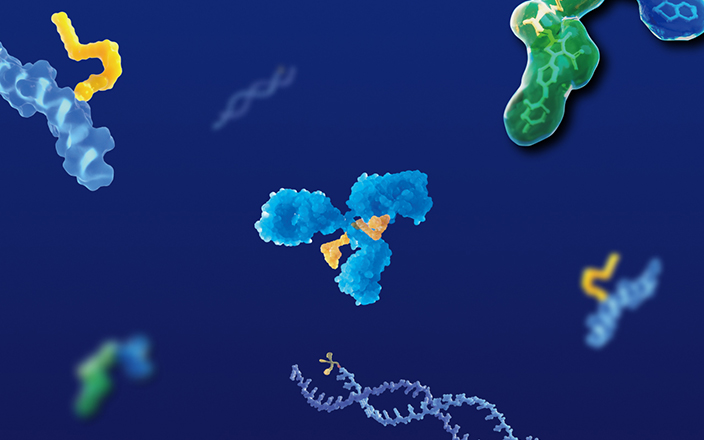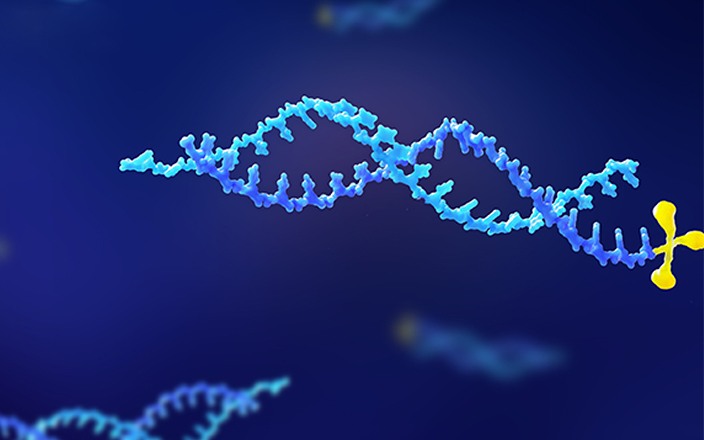Small interfering RNAs (siRNAs) are double-stranded RNA molecules consisting of 19–23 base pairs. They have broad prospects in the treatment of rare diseases, cancer, metabolic disorders, and other diseases. Currently, there are five approved siRNA drugs on the market, and more and more siRNA drugs are entering clinical research stages. Notably, non-clinical early in vivo pharmacokinetic (PK) studies of siRNAs serve as a vital part of the drug development process, which requires diversified bioanalytical platforms. This blog provides relevant bioanalytical solutions for the key analytes in the non-clinical early in vivo PK studies of siRNAs, providing reliable data and a decision-making basis for non-clinical in vivo PK studies of siRNAs and thus accelerating non-clinical studies of siRNA drugs.
Non-clinical early in vivo PK studies of siRNAs involving evaluations of siRNA plasma PK, tissue PK, RISC PK, the degradation efficiency of the target gene mRNA, and the inhibition efficiency of the target protein. Therefore, multiple bioanalytical platforms are necessary for quantitatively detecting different analytes.
siRNA concentration in plasma/tissue: Plasma siRNA concentrations can be quantitatively determined using liquid chromatography–triple quadrupole mass spectrometry (LC-MS/MS) to avoid the interference of metabolites. For siRNA coupled with different delivery systems, suitable bioanalytical methods should be selected based on their structures, such as hybrid-based liquid-phase fluorescence detection (LC-FL), ligand binding assay (LBA), and quantitative polymerase chain reaction (qPCR) to meet quantitative requirements.
Tissue distribution of siRNAs: The study of tissue distribution and tissue PK of siRNAs are critical for non-clinical early in vivo PK studies. The concentration of siRNAs in a tissue can be quantified using a similar LC-MS/MS method to the analysis method used for plasma samples.
Intracellular RISC concentration: Due to the extremely low concentration of RISC-siRNA complex, which may be below 1 ng/g, a more sensitive analysis method is needed for quantitative detection Therefore, RNA immunoprecipitation combined with stem-loop reverse tranion-quantitative polymerase chain reaction (RT-qPCR) is appropriate for the detection of RISCs.
Target gene mRNA degradation efficiency: The level of mRNA degradation directly demonstrates the silencing efficiency of siRNAs, which was examined by the RT-qPCR method with the stable expression housekeeping genes as reference, in order to detect the degradation efficiency of target mRNA. There are two common detection methods, including the SYBR Green dye method and the Taqman probe method.
The inhibition efficiency of target proteins: Target protein levels can be detected by enzyme-linked immunosorbent assay (ELISA), Western blotting, or LC-MS methods. When using ELISA to detect target proteins, the availability of key reagents needs to be considered. If these reagents are difficult to obtain, Western blotting or LC-MS methods can be used for detection.
The Non-GLP Bioanalytical Team of WuXi AppTec possesses comprehensive capabilities in oligonucleotide bioanalysis. We have developed and established the five major bioanalytical platforms: LC-MS/MS, liquid chromatography–high-resolution mass spectrometry (LC-HRMS), hybrid-based liquid chromatography–fluorescence detection (LC-FL), ligand binding assays (LBA), and qPCR. These five bioanalytical platforms support oligonucleotide bioanalysis from early drug screening to IND filing, providing diversified bioanalytical solutions. With our extensive experience in oligonucleotide bioanalytical method development, we can deliver high-quality in vitro and in vivo data to accelerate the drug development process.
If you want to learn more details about the integrated bioanalysis strategies for non-clinical early in vivo PK studies of siRNAs, please read the article now.
Committed to accelerating drug discovery and development, we offer a full range of discovery screening, preclinical development, clinical drug metabolism, and pharmacokinetic (DMPK) platforms and services. With research facilities in the United States (New Jersey) and China (Shanghai, Suzhou, Nanjing, and Nantong), 1,000+ scientists, and over fifteen years of experience in Investigational New Drug (IND) application, our DMPK team at WuXi AppTec are serving 1,500+ global clients, and have successfully supported 1,200+ IND applications.
Talk to a WuXi AppTec expert today to get the support you need to achieve your drug development goals.
Related Services and Platforms




-

 DMPK BioanalysisLearn More
DMPK BioanalysisLearn More -

 Novel Drug Modalities DMPK Enabling PlatformsLearn More
Novel Drug Modalities DMPK Enabling PlatformsLearn More -

 Novel Drug Modalities BioanalysisLearn More
Novel Drug Modalities BioanalysisLearn More -

 Small Molecules BioanalysisLearn More
Small Molecules BioanalysisLearn More -

 Bioanalytical Instrument PlatformLearn More
Bioanalytical Instrument PlatformLearn More -

 PROTAC DMPK ServicesLearn More
PROTAC DMPK ServicesLearn More -

 ADC DMPK ServicesLearn More
ADC DMPK ServicesLearn More -

 Oligo DMPK ServicesLearn More
Oligo DMPK ServicesLearn More -

 PDC DMPK ServicesLearn More
PDC DMPK ServicesLearn More -

 Peptide DMPK ServicesLearn More
Peptide DMPK ServicesLearn More -

 mRNA DMPK ServicesLearn More
mRNA DMPK ServicesLearn More -

 Covalent Drugs DMPK ServicesLearn More
Covalent Drugs DMPK ServicesLearn More
Stay Connected
Keep up with the latest news and insights.















